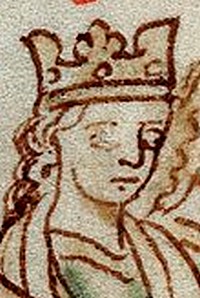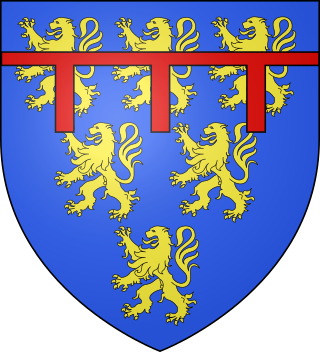Related Research Articles

Eleanor of Provence was a French noblewoman who became Queen of England as the wife of King Henry III from 1236 until his death in 1272. She served as regent of England during the absence of her spouse in 1253.

William Longespée, 3rd Earl of Salisbury was an Anglo-Norman nobleman, primarily remembered for his command of the English forces at the Battle of Damme and for remaining loyal to his half-brother, King John. His nickname "Longespée" is generally taken as a reference to his great physical height and the oversize weapons that he used.

William III de Ferrers, 5th Earl of Derby of Chartley Castle in Staffordshire, was an English nobleman and major landowner, unable through illness to take much part in national affairs. From his two marriages, he left numerous children who married into noble and royal families of England, France, Scotland and Wales.
Peter de Montfort of Beaudesert Castle was an English magnate, soldier and diplomat. He is the first person recorded as having presided over Parliament as a parlour or prolocutor, an office now known as Speaker of the House of Commons. He was one of those elected by the barons to represent them during the constitutional crisis with Henry III in 1258. He was later a leading supporter of Simon de Montfort, 6th Earl of Leicester against the King. Both he and Simon de Montfort were slain at the Battle of Evesham on 4 August 1265.
Thomas de Beaumont, 6th Earl of Warwick, Earl of Warwick, Baron of Hocknorton and Hedenton, was the son of Henry de Beaumont, 5th Earl of Warwick and Margaret D'Oili. He was also known as Thomas de Henry.

Robert FitzWalter, 1st Baron FitzWalter was an English peer.

Walter de Clifford feudal baron of Clifford in Herefordshire, was a Welsh Marcher Lord during the reign of King John (1199–1216).

Katherine Mortimer, Countess of Warwick was the wife of Thomas de Beauchamp, 11th Earl of Warwick KG, an English peer, and military commander during the Hundred Years War. She was a daughter and co-heiress of Roger Mortimer, 1st Earl of March and Joan de Geneville, Baroness Geneville.
Ela of Salisbury, 3rd Countess of Salisbury was an English peeress. She succeeded to the title in her own right in 1196 upon the death of her father, William FitzPatrick, 2nd Earl of Salisbury.
Ela Longespee, Lady of Ashby was a wealthy heiress and daughter of Stephen Longespée, Justiciar of Ireland, and Emmeline de Riddlesford, granddaughter of Walter de Riddlesford. She was the wife of Sir Roger La Zouche, Lord of Ashby.
Maurice Fitzmaurice FitzGerald I, 2nd Lord of Offaly was a Norman in Ireland peer, soldier, and Justiciar of Ireland from 1232 to 1245. He mustered many armies against the Irish, and due to his harsh methods as Justiciar, he received criticism from King Henry III of England. He was succeeded as Lord of Offaly by his son, Maurice FitzGerald, 3rd Lord of Offaly.
Eustace fitz John, Constable of Chester, was a powerful magnate in northern England during the reigns of Henry I, Stephen and Henry II. From a relatively humble background in South East England, Eustace made his career serving Henry I, and was elevated by the king through marriage and office into one of the most important figures in the north of England. Eustace acquired a great deal of property in the region, controlled Bamburgh Castle, and served jointly with Walter Espec as justiciar of the North.

John de Vesci, sometimes spelt Vescy, was a prominent 13th-century noble. He was the eldest son of William de Vesci and Agnes de Ferrers. He married firstly Agnes de Saluzzo and secondly Isabella de Beaumont. John died c. 1289.

William de Vesci or Vescy was a prominent 13th-century noble. He was a son of William de Vesci and his second wife Lady Agnes de Ferrers, daughter of William de Ferrers, 5th Earl of Derby, and his first wife Sibyl Marshal.

William de Vescy, sometimes spelt Vesci, Baron de Vesci, was an illegitimate child of William de Vesci and Devorgille, daughter of Donal Roe Macarthy Mor, Prince of Desmond. He was born in Kildare, Ireland. As he was illegitimate, he had no right to inherit any of his father's properties. In anticipation of this, his father had therefore entered into a number of covenants with Antony Bek, Bishop of Durham designed to enable his son to acquire the properties through entail. Early in Edward I's reign, William asked the king to intervene to enforce the implementation of these covenants.

de Vesci is the surname of an old Norman noble family originating from Vassy, Calvados, also known as the House of de Vesci. The first records are about Robert de Vesci, Norman conqueror and Ivo de Vesci, Lord of Alnwick. The de Vesci family held lands in England, Ireland, Saluzzo in Piedmont and in Sicily. The family was also linked to the Scottish Crown through the marriage of Eustace de Vesci to Margaret, the oldest but illegitimate child and daughter of William the Lion by a daughter of Adam de Hythus. William de Vesci was one of the competitors for the Crown of Scotland, upon the death of Margaret, Maid of Norway in 1290.

The Constable of Chester was a mediaeval hereditary office held by the Barons of Halton. The functions of the Constable are unclear, possibly they related to the custody of Chester Castle, as was the main function of most mediaeval constables, but Sanders (1960) says the office-holder was constable for the entire County Palatine.

Stephen Longespée was an English knight who served as Seneschal of Gascony and as Justiciar of Ireland.
William de Welles, Lord of Welles, was an English noble.
References
- ↑ Cokayne, George Edward (1959). The Complete Peerage of England, Scotland, Ireland, Great Britain and the United Kingdom. The St. Catherine press, ltd. p. 278. Retrieved 21 May 2018.
- ↑ "The chronicle: 1235-61', Annales Cestrienses: Chronicle of the Abbey of S. Werburg, at Chester". 1245. pp. 60–79. Retrieved 20 March 2012.
 This article incorporates text from a publication now in the public domain : "Vescy, John de". Dictionary of National Biography . London: Smith, Elder & Co. 1885–1900.
This article incorporates text from a publication now in the public domain : "Vescy, John de". Dictionary of National Biography . London: Smith, Elder & Co. 1885–1900.